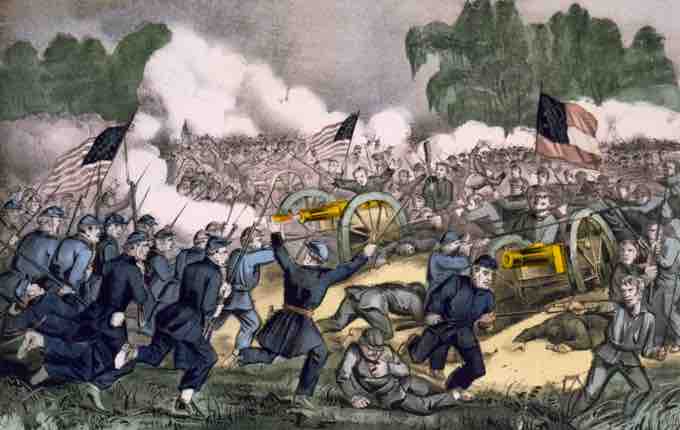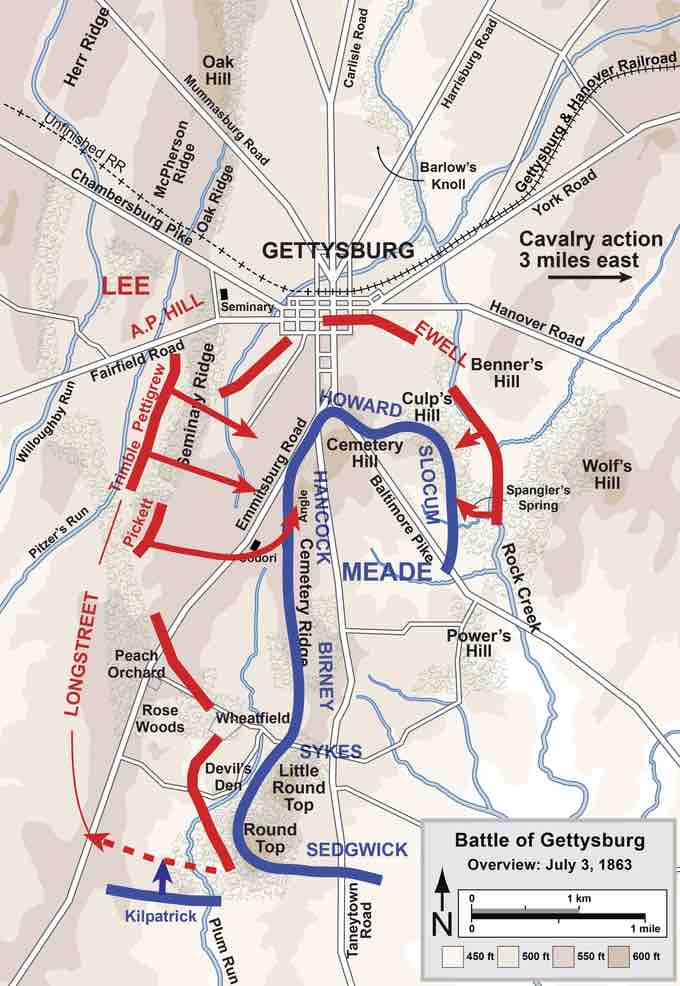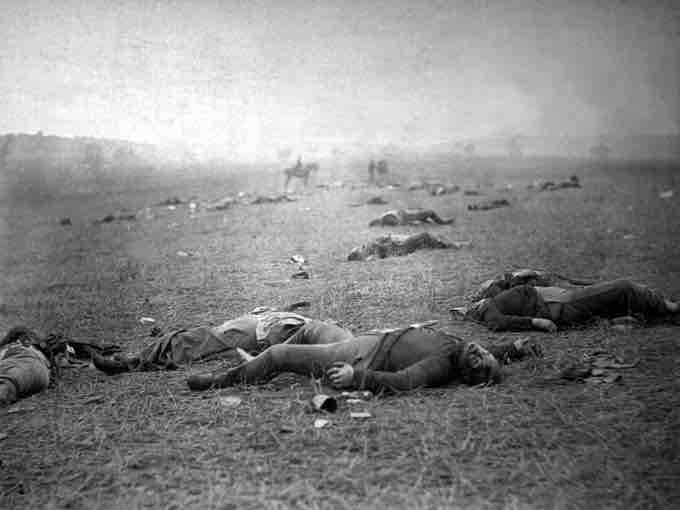The Battle of Gettysburg was fought July 1-3, 1863, in and around the town of Gettysburg, Pennsylvania. As the battle with the largest number of casualties in the American Civil War, it is often described as the war's turning point. Union Major General George Gordon Meade's Army of the Potomac defeated attacks by Confederate General Robert E. Lee's Army of Northern Virginia, ending Lee's invasion of the North.

The Battle of Gettysburg
The Battle of Gettysburg, PA. July 1—3, 1863. The battle was part of the American Civil War and was won by the North. Hand-colored lithograph by Currier and Ives.
After his success at Chancellorsville in Virginia in May 1863, Lee began his second invasion of the North—the Gettysburg Campaign. With his army in high spirits, Lee intended to shift the focus of the summer campaign from war-ravaged northern Virginia and hoped to influence Northern politicians to give up their prosecution of the war by penetrating as far as Harrisburg, Pennsylvania, or even Philadelphia. Such a move would upset federal plans for the summer campaigning season and possibly reduce the pressure on the besieged Confederate garrison at Vicksburg. The invasion would allow the Confederates to live off the bounty of rich Northern farms while giving war-ravaged Virginia a much-needed rest. In addition, Lee's 72,000-man army could threaten Philadelphia, Baltimore, and Washington, and possibly strengthen the growing peace movement in the North.
Elements of Meade's and Lee's armies initially collided at Gettysburg on July 1, 1863, as Lee urgently concentrated his forces there. His objective was to engage the Union army and destroy it. On the second day of battle, most of both armies had assembled. In the late afternoon of July 2, Lee launched a heavy assault on the Union left flank, and fierce fighting raged at Little Round Top, the Wheatfield, Devil's Den, and the Peach Orchard. On the Union right, demonstrations escalated into full-scale assaults on Culp's Hill and Cemetery Hill. All across the battlefield, despite significant losses, the Union defenders held their lines.
On the third day of battle, July 3, fighting resumed on Culp's Hill. The main event was a dramatic infantry assault by 12,500 Confederates against the center of the Union line on Cemetery Ridge, known as Pickett's Charge. The charge was repulsed by Union rifle and artillery fire at great losses to the Confederate army. Nearly one half of the attackers did not return to their own lines. Lee led his army on a torturous retreat back to Virginia.

Map of Gettysburg Battle
Overview map of the third day of the Battle of Gettysburg, July 3, 1863.
The two armies suffered between 46,000 and 51,000 casualties. Union casualties were 23,055, while Confederate casualties are estimated from 23,231 to as many as 28,000. The casualties for both sides during the entire campaign were estimated at 57,225. Contemporary observers often describe that, "the town of Gettysburg looked as if some universal moving day had been interrupted by catastrophe".

Incidents of the War
"The Harvest of Death": Union dead on the battlefield at Gettysburg, Pennsylvania, photographed July 5 or July 6, 1863, by Timothy H. O'Sullivan.
The news of the Union victory electrified the North, with enthusiasm dissipating as the public realized that Lee's army had escaped destruction and the war would continue. The Confederates had lost politically as well as militarily. President Lincoln, upon hearing of the Gettysburg results, refused requests for negotiation. As the news reached London, any lingering hopes of European recognition of the Confederacy were finally abandoned. The immediate reaction of the Southern military and public sectors was that Gettysburg was a setback, not a disaster, as the Union army failed to completely destroy the retreating army.
The significance of the Battle of Gettysburg has been the subject of controversy for years. Although not seen as overwhelmingly significant at the time—particularly since the war continued for almost two years afterwards—in retrospect, many historians consider it a "turning point", usually in combination with the fall of Vicksburg the following day. This is because, after Gettysburg, Lee's army conducted no more strategic offensives, whereas prior to Gettysburg, Lee had established a reputation as an almost invincible general, achieving stunning victories against superior numbers. The two victories also cut off Arkansas, Louisiana, and Texas from the rest of the Confederacy, and provided an obstacle to communication with Confederate forces in the Trans-Mississippi Theater for the duration of the war, effectively cutting the Confederacy into two and making replenishment of supplies much more difficult.
The ravages of war were still evident in Gettysburg more than four months later when, on November 19, the Soldiers' National Cemetery was dedicated. During this ceremony, President Lincoln honored the fallen and redefined the purpose of the war in his historic Gettysburg Address. Between 46,000 and 51,000 soldiers from both armies were casualties in the three day battle.